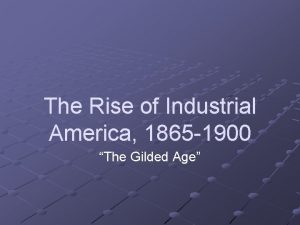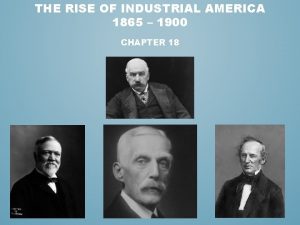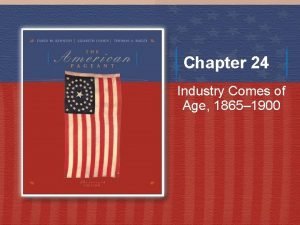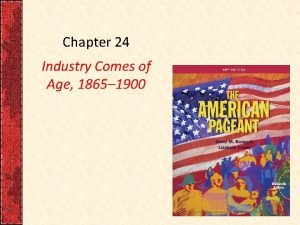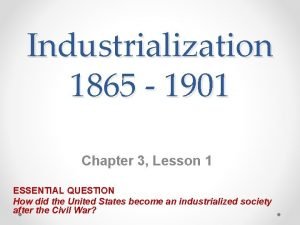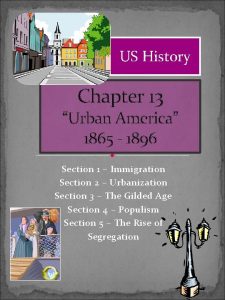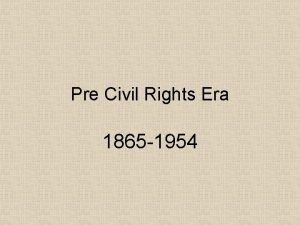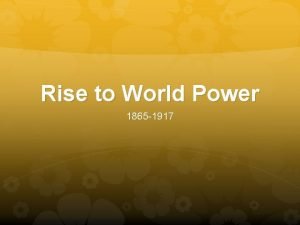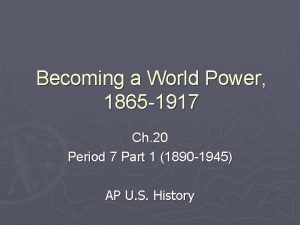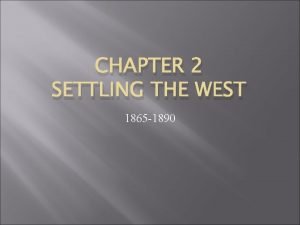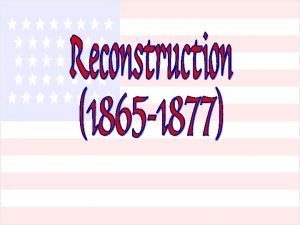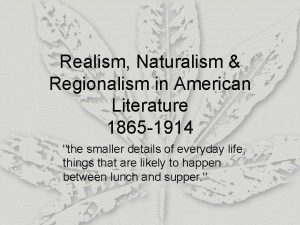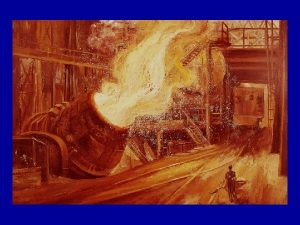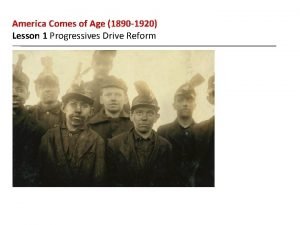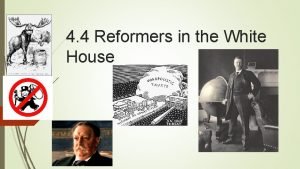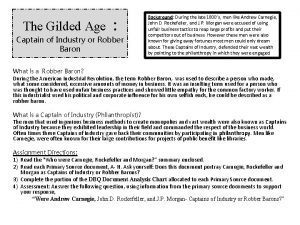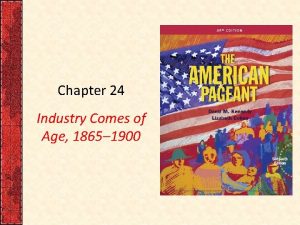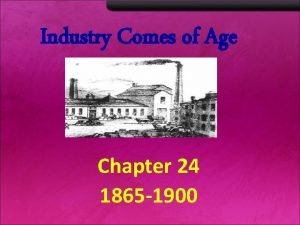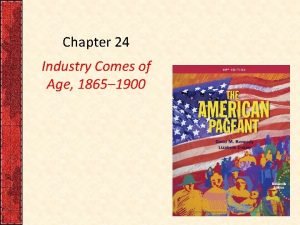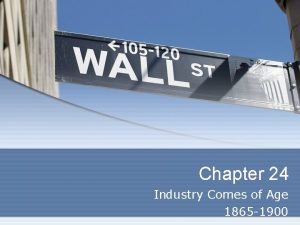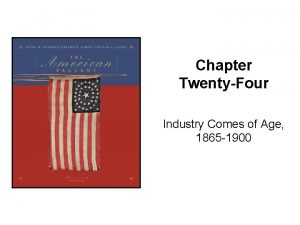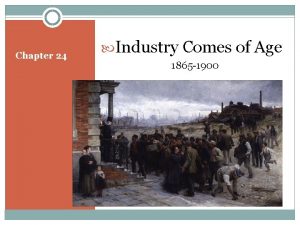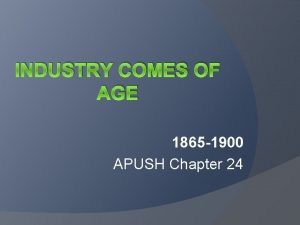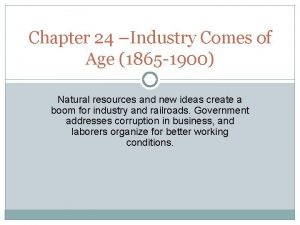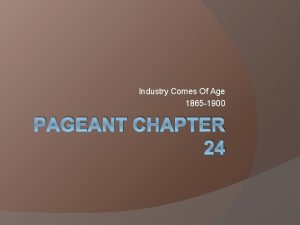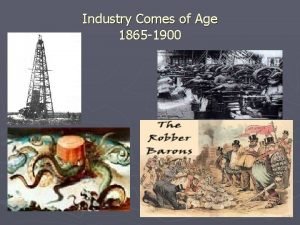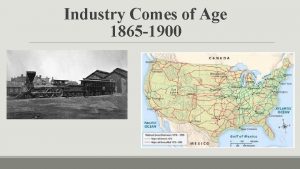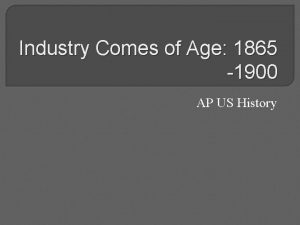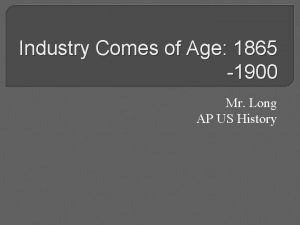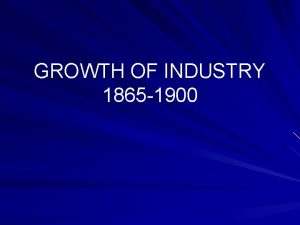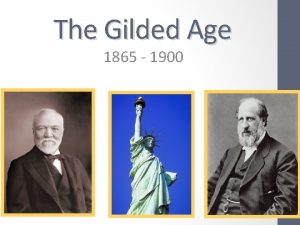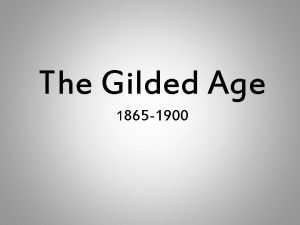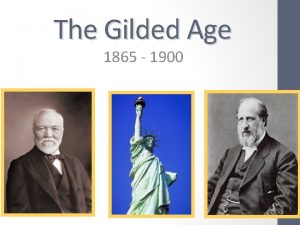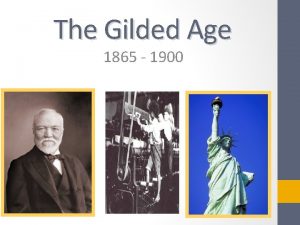Chapter 24 Industry Comes of Age 1865 1900



























- Slides: 27

Chapter 24 Industry Comes of Age 1865 -1900

Growth of Railroads • 35, 000 miles of track in 1865 vs. 192, 556 miles in 1900 • US government subsidies • Land grants= $ for railroad companies • Railroads brought “civilization” to the West • 1862= transcontinental railroad • Union Pacific Railroad= west from Omaha, Nebraska (Irish)

Federal Land Grants to Railroads The heavy red lines indicate areas within which the railroads might be given specific parcels of land. As shown in the inset, land was reserved in belts of various widths on either side of a railroad’s right of way. Until the railroad selected the individual mile-square sections it chose to possess, all such sections within the belt were withdrawn from eligibility for settlement.

Promoting the Union Pacific Railroad, 1869

Growth of Railroads • Central Pacific Railroad= east from Sacramento, California (Chinese) • “Big 4” financed • 2 lines met at Ogden, Utah= western growth • 4 other transcontinental RR by 1900 • Northern Pacific Railroad • The Atchison, Topeka and Santa Fe • The Southern Pacific • The Great Northern

The Union Pacific and the Central Pacific Link at Promontory Point, Utah, May 10, 1869 Railroad financiers, dignitaries, spectators, and Chinese (Central Pacific) and Irish (Union Pacific) work gangs witnessed the historic joining that created the nation’s first transcontinental railroad. After the two locomotives chugged within a few feet of each other, Central Pacific chief and former California governor Leland Stanford tapped a golden spike into a prepared hole on the last tie with a silver-plated maul.

Growth of Railroads • Cornelius Vanderbilt= replaced iron ties with steel • Standardized rails • Westinghouse air brake • Pullman Palace Cars • Linking US with RR= new markets and raw materials • New settlements along RR • Ecological problems • Time Zones established

Traveling First Class This sumptuously appointed Pullman Palace Car offered its prosperous passengers the comforts of home while they were far away from it.

Government Intervention • Common people devoted to free enterprise • Panic of the 1870’s= farmers began protesting RR corruption (The Grange) • Wabash case 1886 • Interstate Commerce Act 1887 • Interstate Commerce Commission (ICC)

Captains of Industry • Andrew Carnegie (Carnegie Steel) • Vertical integration= cartel • John D. Rockefeller (Standard Oil) • Horizontal integration= monopoly • JP Morgan (JP Morgan and Company)financier and banker

J. P. Morgan (1837– 1913) As the most influential banker of his day, Morgan symbolized to many people the power and arrogance of “finance capitalism. ” The chronic skin disorder on his nose inspired the taunt “Johnny Morgan’s nasal organ has a purple hue. ”

Washington as Seen by the Trusts, 1900 “What a funny little government, ” John D. Rockefeller observes in this satirical cartoon. His own wealth and power are presumed to dwarf the resources of the federal government.

Steel Industry • “Steel is King!”= heavy industry • 1870’s: Cornelius Vanderbilt and his NY Central RR • By 1890’s= US producing 1/3 of world’s steel • Bessemer Process • US had all the right ingredients for steel making

Steel Industry • Andrew Carnegie in Pittsburgh • Eliminated middlemen • By 1900= ¼ of US’s steel ($25 million/year) • JP Morgan= deal to buy Carnegie Steel for $480 million • Created US Steel in 1901= 1 st billion dollar company • Carnegie retired to philanthropy

Oil Industry • 1859: first oil field kerosene • Internal combustion engine= oil revived • John D. Rockefeller and Standard Oil • Eliminate middlemen and competition • By 1877 controlled 95% of oil refineries • Forced rebates from railroads, spies in other companies • Other trusts formed- Captains of Industry or Robber Barons?

The Octopus, 1904 This cartoon visually captures a feeling of widespread resentment against Standard Oil as a powerful, sprawling “octopus” whose tentacles controlled all branches of government.

The Gospel of Wealth • Wealthy class saw wealth as helped by divine intervention • Andrew Carnegie and The Gospel of Wealth 1889 • Most subscribed to Social Darwinism • Emerging Plutocracy class divide widening • Used Constitution to protect business

Sherman Anti-Trust Act • Federal government needed to step in to curb monopolies • 1890 passed Sherman Anti-Trust Act • No combinations in restraint of trade • Failed to stop monopolies in early daysactually used against unions • Would be used in future successfully

Changing America • Wealth and standard of living increasing • Immigrants- no longer a society for “yeomen farmers” • Women in “female friendly” jobs= economic and social opportunities • Delayed marriage and children, paid less • The Gibson Girl image • Class division= socialist/radical criticism • US= nation of wage earners- tied to economy more

Gibson Girl, 1899 Illustrator Charles Dana Gibson created a sensation with his drawings of healthy, athletic, young women. The image of the “Gibson Girl” inspired new standards of female fashion as the twentieth century opened, and came to symbolize women’s growing in dependence and assertiveness.

American Industry in 1900

Breaker Boys at South Pittson, Pennsylvania, 1911 Photographer Lewis Hine captured the grimness of these mine helpers’ lives. For hours they sat on benches above a moving belt, breathing coal dust deep into their lungs and kicking large pieces of coal with their feet, breaking the lumps to uniform size for shipment. Photographs like this one became icons of the reform crusade against child labor, a campaign that succeeded only with the passage of the Fair Labor Standards Act in 1938.

Labor Movement • 1872: 32 national unions • National Labor Union 1866 • 8 hour work day, arbitration • Hurt by the Panic of 1870’s • The Knights of Labor 1869 took over as leader in labor movement • Led by Terence V. Powerderly • Skilled and unskilled • Safety codes, arbitration, 8 hour work day

The Strike, by Robert Koehler, 1886 Scenes like this were becoming more typical of American life in the late nineteenth century as industrialism advanced spectacularly and sometimes ruthlessly. Here Koehler (1850– 1917) shows an entire community of men, women, and children —many of them apparently immigrant newcomers—challenging the power of the “boss. ” The scene is tense but orderly, though violence seems to be imminent as one striker reaches for a rock.

The Haymarket Riot • May Day strikes 1886 Chicago had socialists and anarchists • Police killed 4 strikers rally called for at Haymarket Square • Police about to advance on strikers when a bomb was thrown (May 4)- opened fire • Anarchists arrested- 5 sentenced to death, 3 to life in prison • 1892 Governor John P. Altgeld • Haymarket Riot hurt Knights • Knights divided between skilled and unskilled- left for AFL

The American Federation of Labor • AFL 1886 led by Samuel Gompers= federation of unions • Wanted closed shop agreements • Skilled labor union (craft)- 50, 000 by 1900 (only 3% of workers) • Faced problems between 1886 -1900 • 23, 000 strikes, 6, 610, 000 workers affected, $450 million lost • Some industries accepted unions, most still focused on destroying

Samuel Gompers (1850– 1924) Gompers (second from the right in the first row), shown here marching in a labor demonstration in Washington, D. C. , in 1919, once declared, “Show me the country in which there are no strikes and I’ll show you that country in which there is no liberty. ”
 The rise of industrial america 1865-1900
The rise of industrial america 1865-1900 Four features of industrial manufacturing (1865-1900)
Four features of industrial manufacturing (1865-1900) 1865 to 1900 inventions
1865 to 1900 inventions Chapter 24 industry comes of age
Chapter 24 industry comes of age Chapter 24 industry comes of age
Chapter 24 industry comes of age Stone age chronology
Stone age chronology Iron age bronze age stone age timeline
Iron age bronze age stone age timeline Industrialization (1865 to 1901 worksheet answers key)
Industrialization (1865 to 1901 worksheet answers key) First comes love, then comes marriage
First comes love, then comes marriage Urban america 1865 to 1896
Urban america 1865 to 1896 St helen’s smelting co v tipping (1865)
St helen’s smelting co v tipping (1865) 15 th ammendment
15 th ammendment Becoming a world power 1865-1917
Becoming a world power 1865-1917 Impressionism (1865–1885)
Impressionism (1865–1885) Chapter 20 becoming a world power notes
Chapter 20 becoming a world power notes Soddie
Soddie Gregor mendel 1865
Gregor mendel 1865 Where does the term impressionism come from
Where does the term impressionism come from Whats the compromise of 1877
Whats the compromise of 1877 Realism naturalism and regionalism
Realism naturalism and regionalism Industrialization (1865 to 1901 worksheet answers key)
Industrialization (1865 to 1901 worksheet answers key) America comes of age lesson 1 progressives drive reform
America comes of age lesson 1 progressives drive reform Lesson 4 reformers in the white house
Lesson 4 reformers in the white house Captains of industry gilded age
Captains of industry gilded age Agriculture in sangam period was developed in …….. *
Agriculture in sangam period was developed in …….. * Industry vs inferiority erikson
Industry vs inferiority erikson Industry vs inferiority age
Industry vs inferiority age Premature adrenarche
Premature adrenarche
